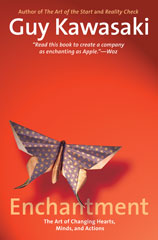As I prepared to write this review, it occurred to me that I owe apologies to a number of people. I tend to make students and others read a lot of books, some good, some bad. The bad ones are usually in there because the books are classics that I believe that everyone should read. Some are there because I was forced to read that book at some point and I wanted others to have to go through the same experience that I went through in reading it. Sorry. Still others are there because I know the book is bad, or at least painfully controversial, and I want to see if the readers can learn and find their voice in reaction to something that they don’t like. Sorry. If you’re one of my “will be someday” students, I’m not going to tell you which book is which. But from that, please learn that people who teach and mentor you did not invent books, and that not everything that they recommend you read is the finest piece of literature you’ve ever seen.
That said, sorry, but Enchantment, by Guy Kaiwasaki is one of the better pieces of literature you’re going to read. I frequently push Guy’s books on other people, and even though they think that the subject matter is odd, or wonder how it applies, they later come back and tell me that his books are profoundly influential. Enchantment is more of the same. As he defines the term, “enchantment” means helping people move from negativity to positivity; turning situations into relationships, hostility into civility; civility into affinity; skeptics into believers; and the undecided into the loyal. In other words, Guy aims very high with this book but again, sorry, he only talks about a way to be – you still have to do the work on your own.
The twelve chapters are well organized and all titled with “How to…,” with the contents clearly defined in the introduction and built on plenty of good examples. Sorry, but Guy being Guy, he’s going to draw considerable inspiration from Apple, since that’s where he got his real break, but he does a very good job of it. If you use a lesser computer, you might find yourself a bit challenged to go with him on that, though. For me, the book really sings in that it give some very specific advice in some things that a poor, socially-challenged person like myself can most use.
Chapter 2, on “How to achieve Likability” is chock-full of advice on things like ow to dress, talk, act, and cuss. I’ve always struggled with dress codes for events that I’ve been a part of. According to Guy, it’s not only okay to ask about it, but it shows that you care enough about your crowd to take it upon yourself to cross that barrier in order to do it right. I really wish I had known that 30 years ago!
The other chapters range from ideas that help you better use the Internet to how to work with people in a business to how to start new ventures to how to resist the temptation to give in too easily to others. There is a lot of good information in there, and I found myself looking forward to the day when I could pass this material on to people with whom I work on a daily basis. All of this is buttressed with stories in every chapter of people who have learned from their experiences, and it helps you find yourself within their stories. Sorry if they are not the stories you’re looking for, but they help, nonetheless.
One last apology. When I first got the book, I sent the following “quick post” to some people who sometimes take my advice about books: “This is “Selling the Dream 2” and a great sequel that reflects his learning over the 20 years between volumes. If you don’t read it and are trying to work with people, there’s either something really wrong with you or you’re just stupid.” In retrospect, I owe them an apology for that, too. That was way too tepid an endorsement.


Follow Us!